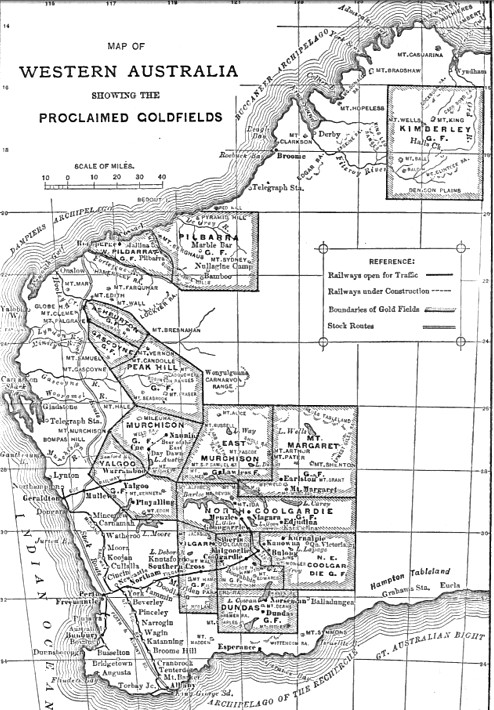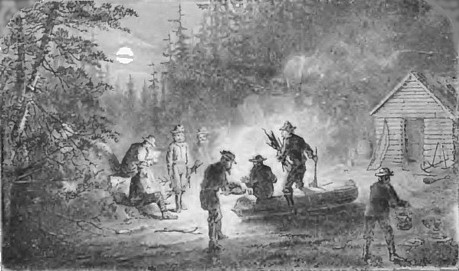The principal gold-field of West Australia is situated in the southwestern part of the desert plateau. The chief towns are Coolgardie and Kalgoorlie.* They are connected by 350 miles of railway with the coast During the year 1897 the total rainfall amounted to 5f inches at the one place and 4| inches at the other, f In contrast to these figures, it may be added that the rate of evaporation in this region is estimated to be equivalent to 7 feet per annum. The country consists of a sandy plain, the monotony of which is intensified by a series of alternating low rocky ridges and equally slight depressions, having a northwesterly direction. Most maps indicate the occurrence of lakes and the occasional course of a stream, but these are the mirages of the cartographer. The " lakes" are shallow basins with clay bottoms, in which, during the rainy season, a little water lingers, and the " streams " are sandy channels, where sinking will sometimes tap a trickling flow of brine. The surface is devoid of vegetation, except in spring, when flowers of a brilliant hue, but with the texture of hay, leap into brief existence. Animal life is infrequent. An occasional bustard may be provoked into leisurely flight, a troop of paroquets throws a momentary gleam athwart the dull gray of the bush, or a solitary kangaroo hops across the trail. These, however, are but infrequent interruptions to the sullen silence of the wilderness. The real nakedness of the region is hidden by the "bush," consisting of scrub from 20 to 60 feet high, chiefly mulga and ti-tree. This covers all things as with a garment.
The roads are cut through it with the monotonous regularity of a canal. One portion to the journey is but the counterpart of another. The sameness is wearisome beyond words. When an elevated spot is attained the eye commands, from north to south, from east to west, one dark unbroken sea of trackless hush. Gold-mining caused this desert to be invaded. As early as 1861 a prospector found auriferous stone 30 miles east of Northam, but could never re-discover the place. In 1862 the Government engaged Mr. E. H. Hargraves, the discoverer of gold in New South Wales in 1851, to prospect and inspect the country for gold. Mr. Hargraves' opinion as published, ''The Non-Auriferous Character of the Rocks of Western Australia," shows how the practical man will theorize, even to his own undoing. In 1864 Mr. C. C. Hunt headed parties which penetrated the country to the Dundas Hills, Lake Lefroy, and probably passed over the Coolgardie goldfields. They named the "Hampton Plains" after the Governor of the day, but only looked upon the country from a pastoral point of view. In 1869 the Government offered a reward of 5000 for the discovery of a goldfield within 300 miles from any port, to be paid after 5000oz. had been won; a still more progressive step was taken in 1873, when 16 Ballarat miners were imported to prospect and mine for precious metals. A battery was erected at Fremantle. This venture ended in failure. In 1885 the Kimberley goldfield was opened up, and in the following year 2000 men had been attracted to the place. This marks the first successful move which has resulted in the modern discoveries in WA. Prospectors again set eastward from Northam, and the first discovery was made by Anstey, in 1887, at Yilgarn, which is 210 miles east from Perth, the capital of the colony. This started the Southern Cross mining district. Prospectors began to scatter further inland. From that time for a number of years new fields were proclaimed with feverish haste Pilbarra, Ashburton, Murchison, Cue, Siberia, were all discovered before 1891. In April, 1892, Bayley and Ford started eastward over that desolate, dreary strip which lies to the east of Southern Cross. After having been beaten back for want of water they slightly changed their course, and arrived at the native well at Coolgardie where they camped. During the next three days they picked up 200oz. of alluvial gold. Returning to Southern Cross for provisions they hurried back to the scene of their find, and on the day they reached Coolgardie for the second time discovered the famous Bayley's Reward mine. The first afternoon's work gave them 500oz. in specimens. Bayley returned and showed 554oz. to Warden Finnerty on the 17th September, and obtained a lease on his discovery claim.
The gold fever seized the
local inhabitants, and in less than a week hundreds were on the way to the
latest land of promise. Kalgoorlie was discovered in June, 1893. At that
time, Patrick Hannan pegged out a discovery-claim at Kalgoorlie, 25 miles
east of Coolgardie. The find which he made was of no particular importance,
and the neighboring area, like many others, became the scene of the
purposeless digging which was at that time sufficient to give an impetus to
a great deal of reckless company promoting. However, just as, in Colorado,
the Mt. Pisgah fiasco of 1884 preceded the real development, eight years
later, of Cripple Creek, so the vagaries of irresponsible schemers led to
the accidental opening up and the eventual recognition of the magnificent
series of rich lodes that have now placed Kalgoorlie among the grteatest
mining camps of the globe. During the next three years series of rich finds,
scattered over the surrounding desert, gave rise to the goldfield
settlements of Menzies, Goongarrie, Kanowna, Kurnalpi, Kunanalling, "Wagiemoola,
Bulong (I.O.U.), The Londonderry, the Wealth of Nations, Menzies, the
Norseman, and a score of other patches of corrugated-iron hideousness
labeled with euphonious aboriginal names. In 1897 West Australia produced
674,993 ounces of
gold, to which Kalgoorlie
alone contributed 306,000 ounces. During the same period the mines of the
colony paid $2,400,420 in dividends, and out of this total, Kalgoorlie is
credited with $1,775,000. The growth of the industry is exhibited by the
accompanying statistics :
Total Kalgoorlie. Total West Australia.
Year. Ounces.
Ounces.
1895, 36,000
231,513
1896, . 103,000
281,265
1897,. 306,000
674,993
It is estimated that the yield of the colony for the current year will reach a million ounces, and that of this one-half will come from the Kalgoorlie district. The development of a group of very rich telluride lodes amid this immense desert country, dotted over with the unhappy failures which were based on small pockets of specimen gold quartz, did not happen without a sad expenditure of money and human life. "With the whisper of every new discovery, crowds of reckless gold-seekers plunged madly into the outer desolation.
Eager horsemen jostled the awkward camels, whose swinging gait carried them in turn past the hundreds of diggers who trudged wearily to the scene of each successive excitement. One knows not whether to admire the pluck or to deride the foolishness of men who died of thirst and perished of fever in the mad search for natural gold. The incident known as "the Siberia gold rush" will be typical of early days. A man came into Coolgardie one night with a story that gold had been found at a locality thirty-odd miles to the north. Hundreds started off on horses or on camels ; many went on foot, carrying their billies and blankets upon their shoulders or trundling their packs in wheelbarrows.
Some took the wrong direction, and of these many never reached their destination, but died miserably in the bush. Four hundred eventually reached Siberia, and the only water near the discovery was a soak, seven miles distant. It was soon drained dry by the crowd of diggers, news came to Coolgardie that a water-famine was imminent. The superintendent of the water-works, a government officer, instantly dispatched a dozen camels to the succor of the adventurers. In the meantime, they, realizing the impending danger, had left the gold, and were making for the nearest condenser. Many died on that return journey, and many more would have been lost save for the water brought by the camel-train. But in a few days there was another stampede in another direction. Thus the gold-fields were opened up.
Continue on to:
The Alluvial Deposits of Western Australia, Part III
Return To:
Important Gold Mining Regions Worldwide


